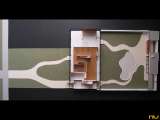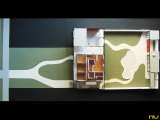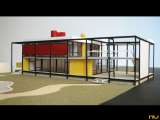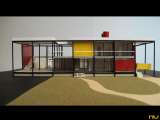|
In 1953, shortly after a visit to Antonio Bonet’s works in Uruguay, engineer Mariano Oks and his wife Martha commissioned the architect with a project for their own house in Martinez, a neighbourhood in northern Buenos Aires residential belt. The site was located in the centre of an urban block; the geometry of the lot reflected an “L” shaped perimeter, 73m (239 ft) long and with a variable width of 19,6m (64 ft) at the façade of Domingo Repetto Street and 28,8m (94 ft) at the rear side of the lot.
Early since the first designs, Bonet locates the rectangular plan of the house in the central and widest area of the lot, separating the parcel into a front access yard at the northwest and another one at the back, more private, with an existent pool facing southeast. The house program divides into day and night zones. The day zone consist of an entrance hall, the living room, a library, the music room, the children’s room and the dining room, all set up at the ground floor 70cm (2,3 ft) above the garden level. In the upper floor, the night zone holds bedrooms and bathrooms, destined both for family and service staff. In the southeast wing a stairway connects the service area at both floors, independent from the main staircase next to the entrance and the living room. A one-storey playhouse, including dressing rooms, closes the rear side of the lot, using equivalent plastic vocabulary of the house’s main volume.
The composition consists of a structural framework of iron I-beams and pillars, with a different modulation for each direction. The starting point for Bonet’s modular design was the division of the lot’s width in seven equal parts, which results in a 4,04 m (13,2 ft) wide space. The length of the module changes along with the project versions, and is finally established in an A-B-C-B-A scheme. These measurements differentiate exterior walkways around the house and a central area for circulations and services.
The iron framework, painted in uncoated black, not only inscribes the house geometry, but also a virtual double-height volume where terraces and balconies are exposed in the east zone, there, a staircase connects through an exterior walkway the upper floor and the garden. A wall covered with earth-coloured ceramic tiles supports the exterior staircase, it helps containing the space jointly with the succession of roofs and the ever-visible structure. The effect is a rich sequence of planes and situations. The simplicity and purity of those planes, the synthesis of structure and space, the mixture of industrial materials and ceramic coloured tile surfaces, remind us of design principles that guide other contemporary works, such as La Ricarda—his first Spanish work—the Cristalplano Pavilion or the project for the Casa Perojo, not built.
(O.H.)
|












